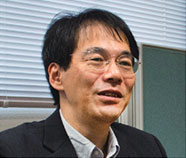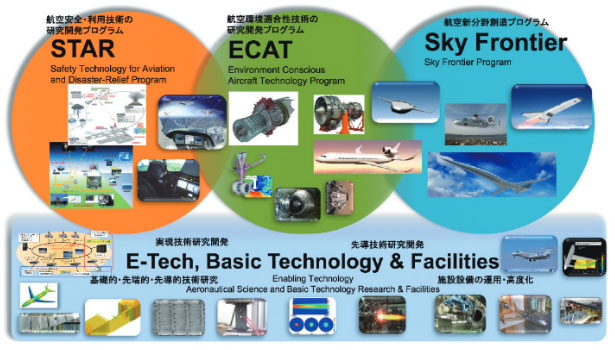About us
JAXA Aviation helps to create a safer and more prosperous society with aeronautics-related research and development activities.
FLIGHT PATH No.22 | 2018 WINTER
JAXA's Aspirations behind the Fourth Mid-to-long-term Plan
Reflecting on ideas discussed by the strategic working group
Toward broader social implementation, stronger fundamental research base, and creation of new value that provides innovative solutions to existing issues
The Fourth Mid-to-long-term Plan outlines what JAXA aims toward over the seven-year period between FY2018 and FY2024. This column introduces interviews with four members of the strategic working group formed within JAXA Aviation Technology Directorate (JAXA Aeronautics), who strove to put together a framework for R&D activities in the aviation field for the plan.
Strategy discussions began around the end of 2015

ITO Takeshi
Head, Strategic Planning Team, Next Generation Aeronautical Innovation Hub Center
When did the strategic working group start meeting?
The Aviation Technology Directorate made a rather early start, compared with other directorates and departments in JAXA, in working toward the Fourth Mid-to-long-term Plan. While the strategic working group was launched in March 2017, preliminary discussions across the directorate (strategic core member meetings) began in the year before around June 2016. It was even earlier in December 2015 when working groups in each of the technical fields (structure and materials, integrated simulation technologies, and supersonic aircraft technologies) commenced activities. Strategy discussions by the Aviation Technology Directorate as a whole were based on all of these earlier efforts.
It seems that the directorate started working on this really early with an eye to the future.
Yes, and that's because the Aviation Technology Directorate has always been thinking about how to develop and promote R&D activities in the aviation field with a view toward the future. Throughout the previous Third Mid-term Plan period, we worked to foster an environment where we can share and discuss various topics widely across the directorate, ranging from the issues we encounter during the planning phase or at the frontline of research, to the changes in future trends of the aviation industry. This environment helped us have productive discussions toward the Fourth Mid-to-long-term Plan.
One of our discussion points was “contribution to the industry,” which is a major characteristic of JAXA Aeronautics. In the Third Mid-term Plan, we put particular emphasis on delivering tangible outputs to feed them to the aviation industry. To make this happen, we've been holding continued dialogs and exchanging opinions with the aviation industry on a daily basis. Moreover, with the launch of the Innovation Hub in 2015, our dialogs have expanded to include fields and industries other than the aviation industry. These activities required us to have a broader perspective, in addition to a medium- to long-term perspective as a research institute, to tackle challenges faced by society at large. As such, we had to become more conscious of the world outside our organization in our thinking.
In order to draw up a practical R&D framework and programs that will serve as pillars for the Fourth Mid-to-long-term Plan, the core members of the strategic working group also performed various analyses such as objective review of the programs pursued under the Third Mid-term Plan and surveys of future trends in the aviation field in Japan and abroad.
Building on these efforts, we discussed our future strategy for the directorate.Our basic stance was to engage in research and development that give consideration to everything from basic and fundamental technology research to research and development of component technologies and future applications. I believe this anew what we've been inherited from the days of the National Aerospace Laboratory of Japan (NAL).
Taking up new challenges while continuing past research and development
What were the objectives of the strategic working group?
Our objectives were to put together the opinions discussed in advance in strategic core member meetings and elsewhere, formulate a comprehensive strategy for the Aviation Technology Directorate to take going forward, and identify core R&D activities that will serve as pillars. We knew how critical our job was since what we came up with would be the foundation for the organization's research in the next seven years.
Where did your discussions begin?
To figure out what the Aviation Technology Directorate really needed and what problems it faced, we began by going over the Third Mid-term Plan and identifying the achievements and issues. In the Third Mid-term Plan, we built a research framework consisting of three main pillars of environment, safety and frontier --The Environment-Conscious Aircraft Technology (ECAT) Program, Safety Technology for Aviation and Disaster-Relief (STAR) Program, and Sky Frontier Program (Sky Frontier) -- on top of the foundation of the Aeronautical Science and Basic Technology Research(Aeronautical Science and Basic Tech), taking an exit-oriented (i.e., application-oriented) approach with a view to social implementation. The biggest challenge was to create a research framework that helps boost the aviation industry. This approach was successful, and I believe the organization became stronger. Since continuity is key to long-lasting research, we kept the basic framework of the three pillars and the basic and fundamental technology research, analyzed each, and considered how to move forward with the programs in our discussions for the Fourth Mid-to-long-term Plan.

A working illustration that the strategic working group used in its discussions for the Fourth Mid-to-long-term Plan. The basic framework consisting of the three pillars and basic and fundamental technology research was retained, and discussions were held on how to move forward with the programs.
What new initiatives do you have in store for the Fourth Mid-to-long-term Plan?
There were three key points that we focused on. One was to build on the activities of the three pillars to date and pursue R&D themes with a clear exit strategy toward broader social implementation. The aFJR project under the Third Mid-term Plan was a success and contributed to the industry with new engine technology. Engine technology will continue to be an important area to work on in the Fourth Mid-to-long-term Plan. Our major challenge is the core engine, an area that has been considered difficult, was seen as a key challenge to overcome in the technological domain. By venturing into this area, we will aim to become more competitive on the international stage. Moreover, we will take on new challenges while continuing past research and development. For example, we're seeing lots of new developments around the world concerning supersonic business jets and passenger aircraft. At JAXA, we plan to build on the achievements of the D-SEND project from the Third Mid-term Plan as a major theme for the Fourth Mid-to-long-term Plan, as we work to further advance our efforts on supersonic transport technologies.
Some of the themes might require cross-program efforts beyond the framework of the three pillars and the basic and fundamental technology research. The strategic working group members recognize this as another area of new challenges.
What new issues emerged out of your reflection on the Third Mid-term Plan?
We were actually concerned that by allocating resources to efforts toward social implementation, we might be undermining our basic and fundamental technology research. This was the second key point. To beef up activities in this area, we decided to focus once again on far-sighted, long-term research. To give an example that illustrates why long-term research is necessary, JAXA has made outstanding achievements in jet engine combustor research which it has been working on for many years. This combustor is capable of achieving one of the lowest levels of nitrogen oxide (NOx) emissions in the world, the kind of technology that would give Japanese manufacturers an edge over global competitors. In our core engine research and development under the Fourth Mid-to-long-term Plan, we will be taking this combustor technology to the next level. To produce technology like this, it takes a considerable amount of time, especially in the aviation field given its enormous scale. That's why we aim to enhance our basic and fundamental technology research in longer term. Integrated simulation is one of our key focuses in this area.
So you're basically sowing the seeds of technology needed to compete globally.
Yes, and since we start from fundamental research, of course it's going to take time. The kind of technology we're talking about can only be realized with the work of researchers who spend their entire careers working on it. I believe finding new research topics that will lead to the creation of that kind of technology is extremely important.
What is the third key point?
It is to create new value and to aim for innovative solutions to existing issues. During the Third Mid-term Plan, JAXA launched the Next Generation Aeronautical Innovation Hub Center, which collaborates with partners in different fields and industries. The Aviation Technology Directorate's projects are pursued with social implementation itself as an objective, but the social implementation the Innovation Hub is trying to achieve looks farther into the future and aims to create totally new methods and value. As such, extensive cross-disciplinary and cross-industrial cooperation, as well as activities leveraging synergy created through internal collaboration, is essential for the Innovation Hub, and in the Fourth Mid-to-long-term Plan, strengthening its activities will also be an important point.
The WEATHER-Eye consortium has already started activities within the Innovation Hub.
There are consortia on the electrification of aircraft and equipment software as well. Electrification is an area that has been gathering attention in recent years, and aircraft equipment is also an area with strong demand from the industry. As we were discussing these topics in the strategic working group, we came to the conclusion that these are areas that JAXA needs to take the initiative on and must be tackled immediately. These areas are rather new to JAXA, and they were listed as themes for the Innovation Hub to work on.
The Innovation Hub's activities are not just aimed at social implementation; they also have the potential to create new fundamental technology through open innovation. As such, the Innovation Hub plays an extremely important role for the Aviation Technology Directorate, also in the interest of strengthening basic and fundamental technology research as stated above.
So external collaboration is going to become even more important.
Exactly. As for the Innovation Hub's activities, we are hoping to create new trends in the aviation field, such as the electrification of aircraft as I mentioned earlier, not just by leveraging JAXA's advanced technologies but also by combining them with promising technologies outside the organization. In order to accomplish that, we need to build on the research and development that continue from the days of the NAL with our eyes fixed on the future. By doing so, I believe we will be able to make broader contributions to the aviation industry that will open up possibilities to take on various new challenges.
What kind of impression did you have as a coordinator of the strategic working group?
The members of this strategic working group were in a position to serve as a bridge between management and the people working at the frontline leading JAXA's R&D activities in aviation field. As proud researchers and engineers, they listened to the opinions of experts both inside and outside JAXA and engaged in repeated discussions with their eyes fixed on the future of JAXA's aviation related R&D activities. It is my hope that young researchers and engineers will engage in their own works with passion and enthusiasm, while also thinking about the path ahead for the Aviation Technology Directorate in the Fourth Mid-to-long-term Plan and beyond.
JAXA's Aspirations behind the Fourth Mid-to-long-term Plan
Reflecting on ideas discussed by the strategic working group
- Toward broader social implementation, stronger fundamental research base, and creation of new value that provides innovative solutions to existing issues
- Accelerating core engine technology research
- Using integrated simulation technologies to solve complicated multidisciplinary problems
- Building on past research to make silent supersonic passenger aircraft a reality